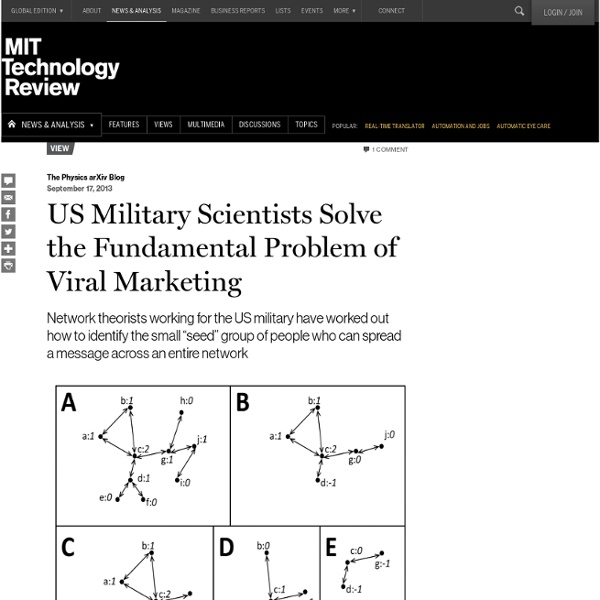New research to uncover nuances of networks
Feb. 20, 2013 9:01 a.m. When a species disappears from a region, the rest of the ecosystem may flourish or collapse, depending on the role that species played. When a storm rolls across the coast, the power grid might reconfigure itself quickly or leave cities dark for days. A snowstorm might mean business as usual in a hardy city and a severe food shortage in another, depending on the distribution strategies of residents. Each of these systems is a kind of network, with thousands of members and relationships linking them. With current network theory, scientists can predict a few simple trends, such as which web pages are likely to get more hits over time. A new four-year, $2.9 million grant from the Defense Advanced Research Projects Agency is supporting SFI research that will, the researchers hope, propel their understanding of networks to the next level. Nodes and links in real networks are cloaked in details, he says. They have already made progress.
How to Burst the "Filter Bubble" that Protects Us from Opposing Views
The term “filter bubble” entered the public domain back in 2011when the internet activist Eli Pariser coined it to refer to the way recommendation engines shield people from certain aspects of the real world. Pariser used the example of two people who googled the term “BP”. One received links to investment news about BP while the other received links to the Deepwater Horizon oil spill, presumably as a result of some recommendation algorithm. This is an insidious problem. Much social research shows that people prefer to receive information that they agree with instead of information that challenges their beliefs. This is the filter bubble—being surrounded only by people you like and content that you agree with. And the danger is that it can polarise populations creating potentially harmful divisions in society. The result is that individuals are exposed to a much wider range of opinions, ideas and people than they would otherwise experience. It’s certainly a start.
1+1=1 : la formule des réseaux
On parle de réseau lorsque des éléments interagissent entre eux au sein d’un groupe. Ils sont étudiés aussi bien par les sciences humaines et sociales, les sciences du vivant et de la terre, que les sciences et techniques de l'information et de la communication. De façon étonnante, tous ces réseaux apparemment distincts ont certains points communs. Ce texte cherche à proposer une synthèse accessible à des non-spécialistes de ce qui est commun (mais aussi différent) dans les différents types de réseaux. La triade « constituants, règles, réseau » Souvent nous tentons d’aborder un réseau social, technique ou autre par le réductionnisme : en étudiant le comportement de ses constituants. Deux hommes veulent se confronter au tir à la corde. Les constituants plus les règles donnent le réseau Le réseau peut être déterminé par ses constituants et ses règles. En fait il faut considérer les trois aspects avec deux d’entre eux déterminant le troisième. La perte (partielle) de notre capacité à prévoir
Data Visualization Software | Tulip
The DIMES project | Join the journey to map the Internet, download the DIMES agent today
Math algorithm tracks crime, rumours, epidemics to source
(Phys.org) -- A team of EPFL scientists has developed an algorithm that can identify the source of an epidemic or information circulating within a network, a method that could also be used to help with criminal investigations. Investigators are well aware of how difficult it is to trace an unlawful act to its source. The job was arguably easier with old, Mafia-style criminal organizations, as their hierarchical structures more or less resembled predictable family trees. In the Internet age, however, the networks used by organized criminals have changed. Innumerable nodes and connections escalate the complexity of these networks, making it ever more difficult to root out the guilty party. EPFL researcher Pedro Pinto of the Audiovisual Communications Laboratory and his colleagues have developed an algorithm that could become a valuable ally for investigators, criminal or otherwise, as long as a network is involved. The validity of this method thus has been proven a posteriori.
The Global Brain Institute
The GBI uses scientific methods to better understand the global evolution towards ever-stronger connectivity between people, software and machines. By developing concrete models of this development, we can anticipate both its promises and its perils. That would help us to steer a course towards the best possible outcome for humanity. Objectives (for more details, check our strategic objectives and activities) Assumptions We see people, machines and software systems as agents that communicate via a complex network of communication links. Challenges that cannot be fully resolved by a single agent are propagated to other agents, along the links in the network. The propagation of challenges across the global network is a complex process of self-organization.
Small world experiment
The "six degrees of separation" model The small-world experiment comprised several experiments conducted by Stanley Milgram and other researchers examining the average path length for social networks of people in the United States. The research was groundbreaking in that it suggested that human society is a small-world-type network characterized by short path-lengths. The experiments are often associated with the phrase "six degrees of separation", although Milgram did not use this term himself. Historical context of the small-world problem[edit] Mathematician Manfred Kochen and political scientist Ithiel de Sola Pool wrote a mathematical manuscript, "Contacts and Influences", while working at the University of Paris in the early 1950s, during a time when Milgram visited and collaborated in their research. Milgram's experiment was conceived in an era when a number of independent threads were converging on the idea that the world is becoming increasingly interconnected. Results[edit]



